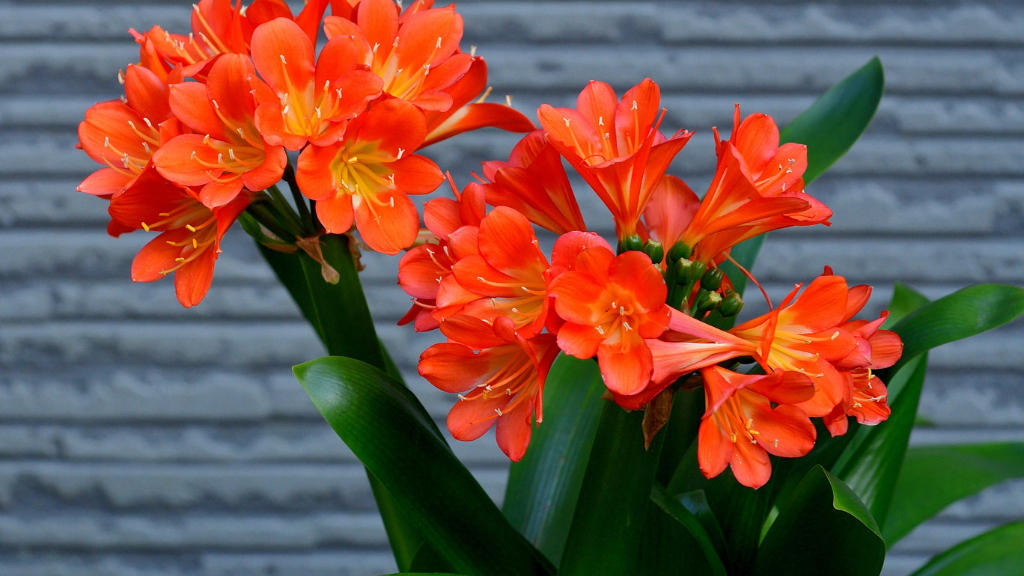Charming Clivia

I’d venture to say that most plant lovers are familiar with amaryllis, but less so with clivia. I’ve written about my clivia before, a gift from my honey, and how much I adore it. I also have a humongous amaryllis bulb that is inching its way up to my number one favorite flowering houseplant... but more about that later.
What Is a Clivia?
Clivia (Clivia miniata) belongs to the lily family (Liliaceae), the same family as amaryllis. It’s easy to see the similarities between the two. Both have similarly shaped flowers clustered together to form what looks like one large head. Although clivia flowers are somewhat smaller than amaryllis both plants have long, strap-like leaves.
Like amaryllis, clivia will bloom if given a 6-8 week cooling period with minimal water in the fall. Unlike amaryllis which drops its leaves, when not in bloom the dramatic evergreen leaves make for an attractive houseplant that can be moved outside when temperatures warm.
Clivia is native to the subtropical forest of South Africa where it can be found growing in partial shade, often atop rotting logs. Orange is the most common clivia color, but a yellow variety exists but is more of a rarity and quite pricey.
I grow my clivia near a southeastern facing window but “near” is the operative word. If I put it right in the bright light of the window, the beautiful leaves soon become sunburned and yellow.
How to Divide a Clivia
I’ve had my clivia for 15 years and in that time, I’ve divided the plant exactly twice. While that may not seem nearly enough for a plant that is about 2 ½ feet (76 cm.) tall and nearly as wide, that fact is that clivia enjoy being root bound. So much so that the first time I went to repot the plant I was seriously alarmed. The entire pot was filled with a swirl of root shaped exactly like the pot. I decided it not only needed repotting but dividing as well.
I was nervous about dividing the plant but with my mental fingers crossed, I sawed through the roots to form three separate plants. One I gave to my mother, one to my sister and the other I repotted for myself. The finger crossing must have worked because today we all have not only surviving but thriving clivia that reliably cheer us in the winter with their large orange heads.
Gardening tips, videos, info and more delivered right to your inbox!
Sign up for the Gardening Know How newsletter today and receive a free copy of our e-book "How to Grow Delicious Tomatoes".
Oh, and on that note, clivia can be propagated by seed or via division. Seeds are a bit of a challenge as they take quite a long time to germinate and about five years before you will be rewarded with a bloom.
Get an Amaryllis to Rebloom
So my clivia is likely my favorite indoor bloomer but I did mention that my amaryllis is edging her out. The amaryllis I’m referring to is only a few years old but the bulb is something to behold; about 6 inches (15 cm.) across! Its other claim to fame is that it bloomed a second time this year…in the summer when it was supposed to be reclining outside gaining energy for a Christmastime bloom!
This shocker has me a bit flummoxed. I’m not sure if the amaryllis has it in itself to bloom again soon but we’re going to find out in a couple of months. In the meantime, I always have my indoor clivia flowers to cheer me up just when the great outdoors is a bone chilling sea of white.

Amy Grant has been gardening for 30 years and writing for 15. A professional chef and caterer, Amy's area of expertise is culinary gardening.
-
 Looking For Plants To Give You The Soft And Fuzzies? Try These 5 Fuzzy Leaf Plant Options
Looking For Plants To Give You The Soft And Fuzzies? Try These 5 Fuzzy Leaf Plant OptionsLovers of texture, drama, silver foliage and tactile plants will adore these special sensory garden additions. These fuzzy leaf plant options will leave you all aglow
By Susan Albert
-
 Get Ready For A Summer Of Hummers! Grow These Full Sun Hummingbird Plants and Flowers
Get Ready For A Summer Of Hummers! Grow These Full Sun Hummingbird Plants and FlowersIf you’re lucky enough to enjoy a sunny backyard, make sure you are maxing out on your pollinator opportunities and grow these full sun hummingbird plants and flowers
By Tonya Barnett